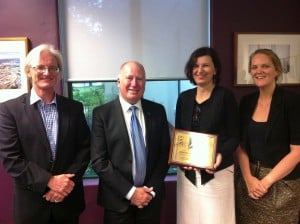
Report from Judging Panel
The judging panel for the second year of these awards consisted of Dr Tracy Ireland, Associate Professor of Cultural Heritage at the University of Canberra; Dr Dianne Firth,
Adjunct Associate Professor of Landscape Architecture at the University of Canberra, who is Deputy Chair of the ACT Heritage Council and Ken Charlton AM LFRAIA, an
architectural historian who is a member of the National Trust of Australia (ACT) Heritage and Grants Committee.
The panel was pleased that the high standard set by most of the entries in the first year of these awards has continued this year. Two entries were each given a plaque for an Award for an Outstanding Project:
Yarralumla Nursery Conservation Management Plan by GML Heritage: Anne Claoué-Long, assisted by Pip Giovanelli, for TAMS, ACT Government.
A project with a high level of historical research and assessment of significance, with clear guidance on site specific heritage elements of the Yarralumla Nursery. It provides a comprehensive history, physical description and heritage assessment, and complements the overarching Weston Park CMP which was given a plaque for an Award for an Outstanding Project in 2014.
ANU Mt Stromlo Observatory Director’s Residence by Amy Jarvis of ANU Heritage; Robert Denton of Tanner Kibble Denton Architects; Jack Harris of Shaw Building Group; Rachel Jackson of GML Heritage; Tony Mosert of Screenmakers and Sarah Barns of ESEM Projects.
A stabilisation and interpretation works project in the Building Conservation Category. This was, until burnt out in in 2003, a fine residence which was of much significance in the
history Mount Stromlo Observatory. A generous Commonwealth grant and matching funds from the Australian National University have been wisely spent. The way the ruin has been stabilised and evidence of its history has been presented is brilliant, with a high level of public accessibility. The exterior has been returned to its 1928 form, with its materials, colours and details restored to a reasonable extent. Only as much as necessary has been done to the internal structure, with interventions clearly visible. Here, the emphasis is on interpretation work, which is most innovative. Stories of aspects of Mount Stromlo’s history, its people and scientific achievements, the house itself and the impact of the 2003 bushfires are well told. The panel’s only criticism is the choice of artificial grass for the croquet lawn.
Two entries were each given a certificate for an Award for a Significant Contribution to Heritage Conservation:
ANU Mt Stromlo Observatory Interactive Heritage Trail by Amy Jarvis of ANU Heritage; Amber Standley of A Positive for app development; Mark Ross of Dotdash for signage design and Tony Mostert of Screenmakers. An interpretation project in the Community Projects Category. Locations for the many signs
have been well chosen for the purpose of explaining the history of the observatory. The interpretation content is excellent and well presented. The innovative use of mobile phone apps is a useful feature of the project. However, the panel was disappointed that only a small map is provided as a method of finding the route between signs. Clearer indications
of the route would be an advantage.
ANU Florey Building, the former John Curtin School of Medical Research by Amy Jarvis of ANU Heritage; Vahan Hekimian of Collard Clarke Jackson Architects; Rachel Jackson of GML Heritage and Lauren Couter of Construction Control. An adaptation and interpretation project. Much care is evident in the adaptation of the building for appropriate new users, with respect for the exterior appearance and conservation of interiors, including the built-in joinery and remarkable bespoke furniture. Period artworks and other relics of the building’s history have been well assimilated into the interior spaces. An appreciation of the history of this important institution and its purpose-built research school has led to impressive methods of interpretation, particularly in publicly accessible spaces, guided by a professional interpretation strategy. The use of historic images as privacy screens is quite innovative.
One project was not given an award:
Hotel Kurrajong by Jeffrey Klein of Togo Group; Total Constructions Pty Ltd and PVH Peckvonhartel Architects. Eric Martin and Associates was the heritage consultant. The transformation of a former hostel and hotel school into a modern hotel, in the building
adaptation category. The way this project has been carried out is commendable for giving new life to a building which has an important place in Canberra’s history and keeping it a vibrant part of Canberra social life. It is good to see a selection of early photographs in the corridors.
